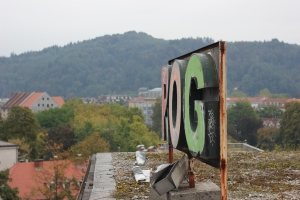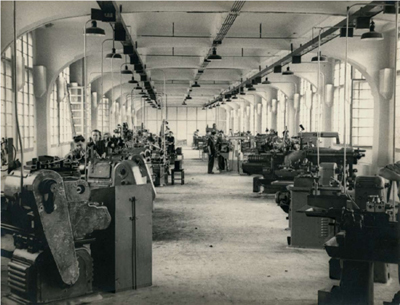 Saturday 25th of March 2006 marked the start of the initiative to open the abandoned bicycle factory Rog for temporary use, with the intent to carry out non-profit, non-established activities on its premises.
Saturday 25th of March 2006 marked the start of the initiative to open the abandoned bicycle factory Rog for temporary use, with the intent to carry out non-profit, non-established activities on its premises.
It is not a classic occupation of space, but a temporary alteration of its purposes. The 7000 square meter large factory – owned by the City of Ljubljana (hereafter MOL) – has already been left to decay for 15 years. As long as MOL doesn’t develop and begin implementing a clear strategy to solve the problem of these empty premises, we self-initiatively wish to open it to all individuals and groups engaged in the non-profit sector, for the realization of independent production of cultural and social content.
As a non-formal network of individuals we believe that our actions are completely legitimate and well-grounded, although, at the moment, lacking official permission. Our action was stimulated by the City Council with their profit-based mentality, bad management, and incorrect reaction to our initiative. At first, MOL agreed to lend these premises for a series of debates, lectures and exhibitions about the temporarily useless building and its future, but later changed its mind and cancelled the verbal contract half an hour before signing the official agreement.
MOL explained that the decision to call off the cooperation was provoked by phone calls from local residents, who complained that “We don’t want a new Metelkova as our neighbour!” Here we would like to point out that we support the grounds on which Metelkova City Cultural Centre is based, but that in the premises of the abandoned factory Rog we wish to develop a different way of action, based on temporality and day activities, and hope to include and satisfy the needs of the local community surrounding it. For that purpose we have started the cleaning and technical renovations of the completely neglected and until now dysfunctional space. We think that a self-initiated and self-organized joint action is urgently necessary in a climate of intolerance and passivity, where one or two phone calls are able to paralyse an initiative carried out voluntarily for the benefit of the local community.
Until the City of Ljubljana finds a solution for the 7000 square meters of unused space in Rog, that very space can – instead of staying merely forsaken and unexploited – host ateliers, music, video or graphic studios, theatre and dance halls, meeting rooms for different associations, playgrounds, social activities etc. We want to open a public space for entirely non-profitable and independent activities, and through this initiative contribute to the quality of art, culture, social health, thought and life in Ljubljana.
In the premises of the abandoned factory Rog, March 29th 2006, at 9 p.m.
Signed:
The temporary users of the factory Rog premises
Source: http://tovarna.org/node/111
The history of the premises of Rog factory on Trubarjeva Street up until the beginning of the temporary use of space:
- 1871The land is bought by Ivan Janesh, who builds a small ground-floor building to use for tanning hides.
- 1879Janesh builds a one-storey tanning workshop on the location of the previous building.
- 1884His sons add a second storey.
- 1900The tannery is bought by Karel Pollak, who renovates and modernises the workshop.
- 1904Pollak encloses the area with a wall and builds a residential villa.
- 1918-19Pollak builds an expansion to the manufacturing premises.
- 1922Two storeys are added by Pollak onto the manufacturing building, with the skeletal construction using the Hennebique system, which is rare in building construction previous to World War I. First such building in Ljubljana. The Czech architect Alois Kral also consults with Plečnik. The factory carries out business successfully.
- 1937Pollak goes bankrupt.
- 1938The factory is bought by Mergenthaller, the owner of a tannery in Vrhnika.
- 1945The expropriation and nationalisation of the leather factory »Indus«.
- 1951-53Re-modelling of the factory and the start of the production of »Rog« bicycles.
- 1991Due to large logistic expenses the management of Rog factory decides to abandon production on Trubarjeva and combine all manufacturing activities in the industrial zone on Letališka Road.
- 1992The process of re-zoning of the space is triggered, anticipating industrial production. It has a sound professional basis and includes a proposal aimed at protecting the manufacturing building by Ljubljanica river.
- 1994City of Ljubljana (Department of Urbanism) carries out a construction test by tender. The process of denationalisation begins. The production of bicycles at this location is abandoned.
- 1995The international Euroculture conference – Rehabilitation of Urban Areas – the evaluation of architectural heritage is organised by the City of Ljubljana. The Rog factory is dealt with as a sample model. The participants of the workshop suggest that the old factory should be protected and put in use for public programmes (studios, ballet school, craft workshops, library…).
- 1997Presentation of Rog factory at the international meeting “Water and the Industrial Heritage” in Venice.
- 1998The city council approves the site terms »PUP CI 5/6 Rog«, under which the old Rog factory is protected. The area is also intended for public programmes.
- 2000The research project regarding cultural sites within the city (by Peace Institute for the City of Ljubljana): Rog factory is proposed for visual arts, dance, music, theatre.Break 21, 4th International Festival of Young Artists (May) and 17th Biennial of Industrial Design (October) are held in the premises of the factory.
- 2001Rog factory on Trubarjeva is bought by the LB-Hypo bank. The denationalising process is over. Within the framework of the urban survey for the preparation of a new spatial plan for the City of Ljubljana, Borut Burger uses Rog factory as an example of a decrepit part of the city centre, and proposes that MOL spearhead an initiative for revitalising this area.
- 2002The City of Ljubljana purchases Rog factory on Trubarjeva (a leasing contract with LB Hypo). Any rumination on renovation dies down in 2003.
Sources
Breda Mihelič (contributions in the 1995 and 1997 Euroculture workshops, research task “Industrial Architecture in Ljubljana up to World War I”)
Borut Burger (contributions in the 1995 and 1997 Euroculture workshops, urban survey “The Inclusions of the City in Rehabilitation of Decrepit Areas and New Uses for Existing Buildings”, 2001)
Autonomous Factory Rog
Trubarjeva 72, 1000 Ljubljana, Slovenia
skupscina-tovarne-rog [at] riseup [dot] net
https://squ.at/r/634
http://atrog.org/
Some squats in Slovenia: https://radar.squat.net/en/groups/country/SI/squated/squat
Groups (social center, collective, squat) in Slovenia: https://radar.squat.net/en/groups/country/SI
Events in Slovenia: https://radar.squat.net/en/events/country/SI
Source: http://tovarna.org/node/113

